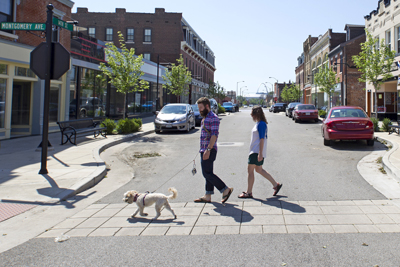
UMSL alumnus Benjamin Koenig, BA psychology 2010, and Abigail Havens walk Mabel across the redeveloped portion of 14th Street in Old North St. Louis. The St. Louis neighborhood is one of many revitalized urban areas discussed in UMSL historian Andrew Hurley's award-winning book "Beyond Preservation." (Photo by August Jennewein)
Public history can breathe new life into an old, crumbling urban district. University of Missouri–St. Louis historian Andrew Hurley knows this because he’s documented portions of inner-city decay that have been revitalized through historic preservation.
In his 2010 book, “Beyond Preservation: Using Public History to Revitalize Inner Cities,” Hurley, chair of the Department of History at UMSL, wrote about dilapidated neighborhoods that went from being doomed by demolition to rebounding through regeneration. The rebirth occurred thanks to a collective embrace for the area’s historic importance. And it led to an increase in property values and tourist revenue with an influx of people returning to city neighborhoods once given up for dead.
Hurley’s effort to shed light on these urban renaissances has gained him honors from the National Council on Public History. It recently named “Beyond Preservation” the recipient of the NCPH Book Award, which recognizes outstanding scholarship that addresses public history theory, practice or both.
“Written in clear prose, Hurley’s book is both firmly engaged in and expands the existing historiography of public history,” read an NCPH statement. “The book describes specific projects in St. Louis and provides a roadmap, particularly for historians working in urban communities where overlapping categories of race, ethnicity and class exert powerful influence on matters of public memory.”
The council further praised Hurley for tackling difficult issues with his book, including gentrification, the conflict of academic authority and community demands.
“But (he) does so in a way that provides concrete strategies for professional historians who may face similar issues,” the NCPH said. “While acknowledging that professional historians may have to share their authority in these circumstances, he also illustrates the ways in which professionals have a vital role to play.”
Based on Hurley’s partnerships with community organizations in St. Louis, “Beyond Preservation” proposes a framework for stabilizing and strengthening inner-city neighborhoods through the rehabilitation and re-use of older buildings. His central argument in the book is that these preserved landscapes can become assets through grassroots planning and public interpretation. He contends that, done correctly, the rehabilitation and re-use of older buildings can strengthen local economies and communities by nurturing a deeper attachment to place, greater levels of social cohesion and a collective agenda for local development.
Read more about “Beyond Preservation” in UMSL Daily.














